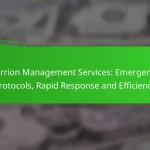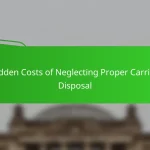What are the environmental benefits of effective carrion management?
Effective carrion management offers significant environmental benefits, including the reduction of greenhouse gas emissions, enhanced soil health, and support for local ecosystems. By properly disposing of animal remains, we can mitigate negative impacts on the environment and promote ecological balance.
Reduction of greenhouse gas emissions
Proper carrion management can significantly reduce greenhouse gas emissions, particularly methane, which is produced when organic matter decomposes anaerobically. By ensuring that carcasses are disposed of in a manner that promotes aerobic decomposition, emissions can be minimized. Techniques such as composting or incineration can be effective in reducing these harmful gases.
For instance, composting animal remains can lower methane production by up to 90% compared to traditional burial methods. This not only helps in climate change mitigation but also aligns with regulations aimed at reducing emissions from waste management.
Enhanced soil health
Effective carrion management contributes to enhanced soil health by returning nutrients to the ecosystem. Decomposing animal remains enrich the soil with essential nutrients such as nitrogen, phosphorus, and potassium, which are vital for plant growth. This natural fertilization process supports agricultural productivity and promotes biodiversity.
Practices like composting can improve soil structure and water retention, making it beneficial for farming and gardening. Implementing these methods can lead to healthier crops and reduced need for synthetic fertilizers, which can be costly and environmentally damaging.
Support for local ecosystems
Managing carrion effectively supports local ecosystems by providing food for scavengers and decomposers, which play crucial roles in nutrient cycling. Species such as vultures, raccoons, and various insects rely on carrion as a food source, and their presence indicates a healthy ecosystem. By ensuring that animal remains are accessible to these organisms, we promote biodiversity.
Additionally, effective carrion management can prevent the spread of disease that may occur when carcasses are left to decay inappropriately. This proactive approach helps maintain the balance of local wildlife populations and supports overall ecosystem resilience.
How does carrion management impact wildlife in urban areas?
Carrion management significantly influences wildlife in urban areas by affecting the availability of food sources and the health of animal populations. Proper management practices can reduce disease transmission among wildlife while supporting scavenger species that play essential ecological roles.
Prevention of disease spread
Effective carrion management helps prevent the spread of diseases among wildlife populations in urban settings. By promptly removing dead animals, the risk of pathogens that can infect scavengers and other wildlife is minimized. This is particularly important in densely populated areas where close contact between species can facilitate disease transmission.
Implementing regular monitoring and removal protocols can significantly reduce the likelihood of outbreaks. For instance, municipalities can establish a schedule for inspecting public spaces and responding quickly to reports of dead animals, thereby protecting local wildlife health.
Promotion of scavenger species
Proper carrion management can enhance the survival of scavenger species, such as vultures and raccoons, in urban environments. By ensuring that carrion is managed effectively, these species can thrive, as they rely on dead animals as a primary food source. This not only supports their populations but also contributes to ecological balance by facilitating nutrient recycling.
Urban planners and wildlife managers should consider creating designated areas where scavengers can safely access carrion without posing risks to public health. This can include establishing wildlife corridors or protected zones that encourage scavenger activity while minimizing human-wildlife conflict.
What are the best practices for carrion disposal in rural regions?
The best practices for carrion disposal in rural areas include composting, burial, and incineration. Each method has its own advantages and considerations, depending on local regulations, environmental impact, and available resources.
Composting methods
Composting is an effective way to manage carrion by transforming organic matter into nutrient-rich soil. This method requires a controlled environment with adequate aeration, moisture, and carbon-to-nitrogen ratios to facilitate decomposition.
To compost carrion, consider using a dedicated compost bin or pile that is isolated from other compost materials. Ensure that the pile reaches temperatures of at least 55°C to kill pathogens and prevent odors. Regularly turning the compost helps maintain aeration and speed up the process.
Burial techniques
Burial is a straightforward method for disposing of carrion, especially in rural settings where land is available. It is crucial to dig a deep enough hole, typically at least 1-2 meters, to prevent scavengers from accessing the remains.
When burying carrion, choose a location away from water sources to avoid contamination. Cover the remains with soil and consider adding lime to neutralize odors and speed up decomposition. Check local regulations to ensure compliance with any specific burial guidelines.
Incineration options
Incineration is a rapid method for disposing of carrion, effectively reducing it to ash and minimizing odors. This method requires a proper incinerator that meets environmental standards to control emissions and ensure complete combustion.
When using incineration, ensure that the facility is equipped to handle animal remains and complies with local regulations. Monitor the temperature to achieve complete combustion, as inadequate temperatures can lead to harmful emissions. Consider the cost of operation and potential environmental impacts when choosing this method.
What regulations govern carrion management in the United States?
In the United States, carrion management is primarily regulated at both state and federal levels, focusing on public health and environmental protection. These regulations dictate how dead animals must be disposed of to prevent disease transmission and environmental contamination.
State-specific guidelines
Each state has its own set of guidelines for carrion management, which can vary significantly. For example, some states may require immediate burial or incineration of carcasses, while others allow composting or rendering as acceptable methods. It’s essential for individuals and businesses to consult their local wildlife or agricultural departments to understand specific requirements.
Additionally, many states have established protocols for reporting dead animals, particularly for species that may pose a risk to public health or are protected by law. Familiarizing yourself with these state-specific guidelines can help avoid fines and ensure compliance.
Federal regulations overview
At the federal level, the U.S. Department of Agriculture (USDA) and the Environmental Protection Agency (EPA) set overarching regulations for carrion management. These agencies focus on preventing the spread of zoonotic diseases and ensuring safe disposal methods that do not harm the environment.
The USDA has specific guidelines for the disposal of livestock carcasses, which may include methods like incineration, burial, or rendering. Compliance with these federal regulations is crucial for agricultural operations to maintain biosecurity and protect public health.
How can local governments improve carrion management strategies?
Local governments can enhance carrion management strategies by implementing effective systems for carcass removal and disposal, ensuring public health and environmental safety. This involves developing clear protocols, engaging the community, and collaborating with relevant organizations.
Community education programs
Community education programs are essential for raising awareness about the importance of proper carrion management. These initiatives can inform residents about the health risks associated with decomposing animals and encourage them to report carcasses promptly.
Workshops, informational pamphlets, and social media campaigns can be effective tools. Local governments should aim to reach a broad audience, including schools, businesses, and community groups, to foster a culture of responsibility regarding animal carcasses.
Partnerships with environmental organizations
Forming partnerships with environmental organizations can significantly enhance carrion management efforts. These organizations often possess expertise in wildlife management and can provide valuable resources and guidance.
Collaborative projects might include joint clean-up events, research on local wildlife populations, and the development of best practices for carcass disposal. Such partnerships can also help secure funding and support for ongoing educational initiatives, ensuring sustainable practices in the long term.
What technologies are emerging in carrion management?
Emerging technologies in carrion management focus on enhancing efficiency and sustainability. Innovations such as biodegradable disposal solutions and smart monitoring systems are gaining traction, offering environmentally friendly and effective methods for managing animal remains.
Biodegradable disposal solutions
Biodegradable disposal solutions utilize natural processes to break down organic matter, minimizing environmental impact. Techniques such as composting and anaerobic digestion convert carrion into useful products like soil amendments or biogas, respectively.
These methods are often regulated under local waste management laws, which may dictate the types of materials that can be processed. For example, composting facilities may require specific permits and adherence to health standards to ensure safe decomposition.
Smart monitoring systems
Smart monitoring systems employ sensors and IoT technology to track the decomposition process and environmental conditions. These systems can provide real-time data on temperature, moisture levels, and odor, allowing for timely interventions if necessary.
Implementing these technologies can help optimize the disposal process, reducing odors and attracting pests. Organizations should consider investing in systems that integrate with existing waste management practices to enhance overall efficiency and compliance with local regulations.
What are the challenges of carrion management in urban environments?
Carrion management in urban areas faces several challenges, including limited space, public health concerns, and regulatory hurdles. Urban settings often have high population densities, making the disposal of animal remains more complex due to potential health risks and environmental impacts.
Space limitations for disposal
Urban environments typically lack adequate space for proper carrion disposal methods such as burial or composting. This can lead to the accumulation of carcasses in public areas, which poses health risks and attracts scavengers. Creative solutions, such as designated disposal sites or partnerships with local waste management facilities, can help mitigate these issues.
Public health concerns
Improper management of carrion can lead to the spread of diseases, attracting pests and creating unsanitary conditions. Urban planners and health officials must work together to establish protocols for timely removal and safe disposal of animal remains. Public awareness campaigns can also educate residents on reporting dead animals to appropriate authorities.
Regulatory challenges
Regulations surrounding carrion management can vary significantly between cities and countries, complicating enforcement and compliance. Urban areas may have specific guidelines regarding the disposal of animal remains, which can include permits and reporting requirements. Engaging with local government to understand these regulations is crucial for effective carrion management strategies.




